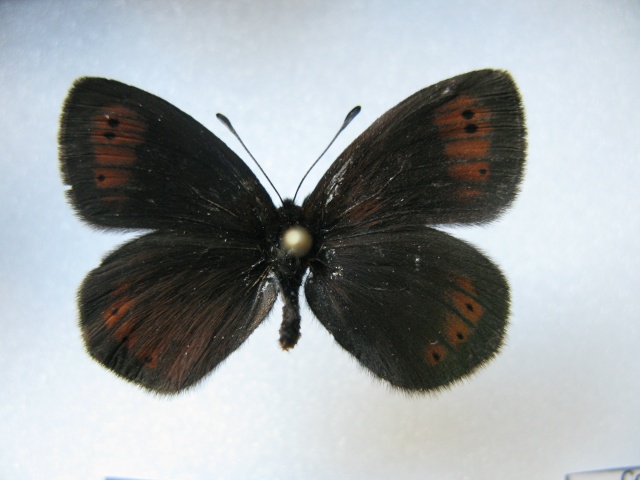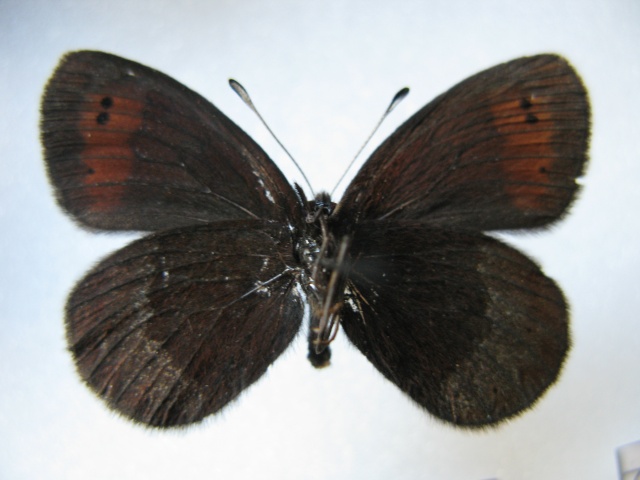|
|
Post by jaguarae on Apr 5, 2014 5:22:01 GMT -8
A natural hybride from France between Erebia epiphron and Erebia pronoe : Erebia hybride "serotina"   |
|
|
|
|
|
Post by homard on Apr 13, 2014 4:24:06 GMT -8
The main purpose of my 'hybridizing' was to test the DNA results which show hippocrates, machaon and brevicauda are all the same species. Adam, my applause to your hard work and patience with all this stuff! BTW congrats with the discovery of the third species of Lamproptera! Dear Felix, Some seriously great work contained within this thread. If however you fancy a real challenge, I can only but suggest the hybridizations between the closely related members of the European Apaturinae ( iris, ilia and metis). Following some serious works by Nguyen (1976 and 1979). "Les Apatura: polymorphisme et speciation : lépidoptères Nymphalidae" and "Polymorphismus und Artabgrenzug in der Gattung Apatura (Nymphalidae)", many believe that A.metis and A.ilia are in fact polymorphic versions of the same species? I can confirm that both A.metis and A.ilia certainly share the same wing pheromone compound, but this is also true however of A.iris. It would be interesting to see how easily these ( A.metis and A.ilia) species actually interbreed and produce viable offspring? Lastly however, it is extremely important to note that the natural captive breeding of any members of the Apaturinae has never been achieved and that recently acquired data has also confirmed that infertility of these species is not simply necessarily due to incompatibility. Recent in-vitro labelling experiments (therefore unknown to Nguyen in 1979) would highly suggest that the males of these species need to ingest various essential factors in order to produce viable progeny. Are you really up for such an immense challenge? Mark Mark, that should be very interesting and challenging work. Meanwhile I'm so far on the ground that ilia and metis are two separate species. They're inhabiting the different biotopes here, fly at different time and larvae consumes a different LFP. Last year I observed thousands of ilia but there was not a single metis. Later I tried into metis biotope but unfortunately did not find a single...  A natural hybride from France between Erebia epiphron and Erebia pronoe : Erebia hybride "serotina" Cool! Do You collected yourself, recently? All that I know of it from the literature, the number of it were collected long ago in trhe past... I have a natural hybrid in Erebia but this would be premature to speak of it as I want to publish a paper on it first. Best regards, Alexei |
|
|
|
Post by bobw on Apr 13, 2014 9:05:29 GMT -8
Dear Felix, Some seriously great work contained within this thread. If however you fancy a real challenge, I can only but suggest the hybridizations between the closely related members of the European Apaturinae ( iris, ilia and metis). Following some serious works by Nguyen (1976 and 1979). "Les Apatura: polymorphisme et speciation : lépidoptères Nymphalidae" and "Polymorphismus und Artabgrenzug in der Gattung Apatura (Nymphalidae)", many believe that A.metis and A.ilia are in fact polymorphic versions of the same species? I can confirm that both A.metis and A.ilia certainly share the same wing pheromone compound, but this is also true however of A.iris. It would be interesting to see how easily these ( A.metis and A.ilia) species actually interbreed and produce viable offspring? Lastly however, it is extremely important to note that the natural captive breeding of any members of the Apaturinae has never been achieved and that recently acquired data has also confirmed that infertility of these species is not simply necessarily due to incompatibility. Recent in-vitro labelling experiments (therefore unknown to Nguyen in 1979) would highly suggest that the males of these species need to ingest various essential factors in order to produce viable progeny. Are you really up for such an immense challenge? Mark Mark I must have overlooked this last year. A few years ago a friend of mine paired A. iris and A.ilia. Some of the eggs were fertile and some of these hatched. I think he ended up with about 30 larvae but they were very weak and none of them made it past 2nd instar. Bob |
|
|
|
Post by jaguarae on Apr 14, 2014 1:30:45 GMT -8
Cool! Do You collected yourself, recently? Yes ! on september 2013 ... it was a beautiful sunny day  The only one specimen was seen on a meadow of short grass . |
|
|
|
Post by homard on Apr 14, 2014 3:47:12 GMT -8
Cool! Do You collected yourself, recently? Yes ! on september 2013 ... it was a beautiful sunny day  The only one specimen was seen on a meadow of short grass . You're really lucky! Congrats! Where did you collect it? In TL of Serotina, near Cauterets? Best regards, Alexei |
|
|
|
Post by jaguarae on Apr 14, 2014 4:07:48 GMT -8
In fact the first specimens were taken near Cauterets but since there was others valley where serotina was found (in spain too )... here it is near Luchon
|
|
|
|
|
|
Post by homard on Apr 14, 2014 4:17:25 GMT -8
In fact the first specimens were taken near Cauterets but since there was others valley where serotina was found (in spain too )... here it is near Luchon Interesting. It's amazing that the species from so different species-group Epiphron and Pronoe are interbreeds so regularly. AFAIK it's the only case of the regular interspecific hybridization in Erebia. I know only one another case of such hybridization in literature from Romania, but that was a single case. |
|
|
|
Post by lordpandarus on Apr 16, 2014 15:09:22 GMT -8
saved this picture from a few years ago. It was a P.maaki hybrid for sale (not mine,but I wish it was) Attachments:
|
|
|
|
Post by crino on Apr 18, 2014 4:45:40 GMT -8
stunning maackii!
|
|
memo
Junior Member
 
Posts: 36
|
Post by memo on Apr 18, 2014 11:40:26 GMT -8
I am wondering if there is any try to crossbreed Morphos or natural hybrids of them? Sometimes ago I saw here an offer of M.rethenor helena x M.reth. cacica(?...I believe). Of course wonderful like the parents but not different.
|
|
|
|
Post by crino on Apr 18, 2014 23:50:51 GMT -8
And I'm wondering how can you know whether a specimen is a hybrid or an aberration, if you don't know about its origin... For example, this P. arcturus could be a hybrid? Picture is unfortunately not mine.  |
|
memo
Junior Member
 
Posts: 36
|
Post by memo on Apr 20, 2014 1:22:53 GMT -8
You're right, I can't know it, as both are from rethenor group. It is like a crossbreed between O. priamus poseidon x O.priamus priamus.
What do yyou know about Morpho hybrids? Is it possible to crossbreed M.peleides x M.polyphemus?
|
|
|
|
Post by wolf on Apr 20, 2014 11:31:58 GMT -8
I posted this picture i found on the inet some time ago. What seems to be P.palinurus and P.polytes pairing.  |
|
|
|
Post by Adam Cotton on May 2, 2014 10:45:34 GMT -8
Here's a composite photo (to save on size) of male and female 'hybrids' between brevicauda and gorganus (Luxemburg) that I released in a flight cage 2 days ago to breed the F2 generation. The female started laying eggs today. The male is on the left, in case anyone is uncertain. Adam.  |
|
felixb
Junior Member
 
Posts: 20
|
Post by felixb on May 8, 2014 8:08:18 GMT -8
hi Adam
in my opinion, these look more intermediate than machaon x polyxenes . very interesting.even the head has some serious machaon markings. brevicauda seems to be closer realted to machaon than polyxenes is.
As I suggest from your post, the Pairing of These hybrids was natural? I also observed a natural Pairing of F1 hybrids between machaon melitensis x polyxenes asterius last year.
best regards!
|
|